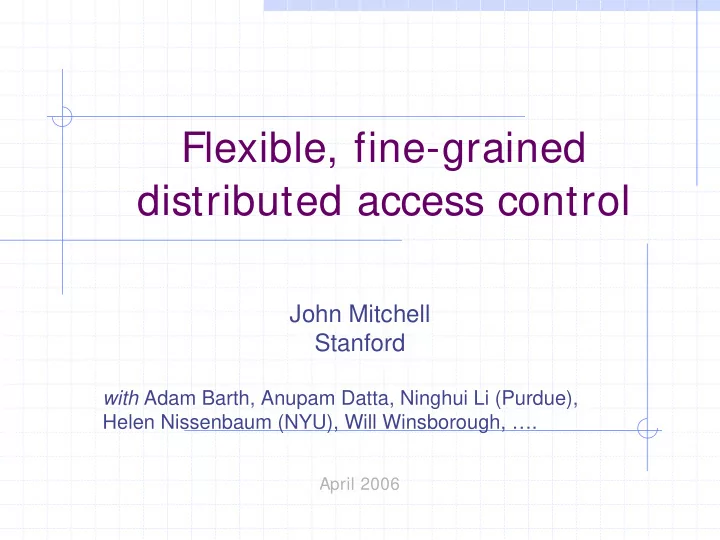

Flexible, fine-grained distributed access control John Mitchell Stanford with Adam Barth, Anupam Datta, Ninghui Li (Purdue), Helen Nissenbaum (NYU), Will Winsborough, …. April 2006
We’re all ears What policy concepts are important in healthcare? What kind of systems should understand or enforce these policies? How can tech geeks be useful? What’s all this talk about Brazilian skiing? mitchell@cs.stanford.edu abarth@cs.stanford.edu
Enterprise Access Control Policy W ho W hat W hen W here W hy Joe can open financials.xls on his laptop using wired SSL Resource Resource User Who Action What Constraint When Where
Traditional mechanisms Assumptions � System knows who the user is � User has entered a name and password, or other info � Access requests pass through gatekeeper � System must not allow monitor to be bypassed Reference monitor User ? Resource process access request policy
Access control matrix [Lampson] Objects File 1 File 2 File 3 … File n User 1 read write - - read User 2 write write write - - Subjects User 3 - - - read read … User m read write read write read Access control list (ACL): column of matrix, often stored at resource
Role-Based Access Control Individuals Roles Resources engineering Server 1 Server 2 marketing Server 3 human res Leverage: user’s change more frequently than roles
Distributed Access Control Policy Resource Policy Policy Resource Resource Protect distributed resources with ID distributed policy Policy at site A may govern resources at site B
Decentralized Policy Example EPub Alice Grants access to university students Trusts universities to certify students Trusts ABU to certify universities Alice is a student StateU ABU StateU is a university
Role-based Trust-management (RT) RT 0 : Decentralized Roles RT D : for RT T : for RT 1 : Selective Use of Separation Role memberships Parameterized Roles of Duties RT 1C : structured resources RT 2 : Logical Objects RT 2C : structured resources RT T and RT D can be used (either together or separately) with any of the five base languages: RT 0 , RT 1 , RT 2 , RT 1C , and RT 2C
Analyze Policy Management Lifecycle Enforce Plan Measure Improve
Policy language design space Permit / Deny Permit only Resolve Can be contradiction contradictory EPAL: Ordered
Policy Combination Denied Denied Denied + = OK Permitted Permitted Permitted Denied Denied Denied + = ?? Permitted Permitted Permitted
Contextual Integrity Framework for privacy: � Concept of contextual integrity � Formalization in Linear Temporal Logic Application to privacy laws: � HIPAA, GLBA, COPPA Related Work � RBAC, XACML, P3P, EPAL
Overview of Contextual Integrity Transfer of information between agents “Alice give Bob information about Charlie” � Categorization � Agents grouped into roles � Information categorized by types Basic policy statements � Manager may read employee’s performance data � If m is a manager, e is an employee, d is performance data about e, and m is e’s manager then m may read d
Formalization in Temporal Logic Syntax of logic Formula representing contextual norms where norms have specific forms
Policy Operations and Relations Standard automated LTL tools are applicable � Policy consistency: LTL satisfiability � Refinement: logical implication � Combination: conjunction and disjunction � Strong compliance: satisfiability � Weak compliance: computable efficiently using concepts from LTL runtime verification
Application: HIPAA Privacy Rule � Covered entities (e.g. hospitals) can give protected health information about patients to health care providers � Sender role: Covered entity � Recipient role: Health care provider � Subject role: Patient � Information type: Protected health information
Application: GLBA Privacy Rule � Financial institutions must notify consumers if they share their non-public personal information with non-affiliated companies, but the notification may occur either before or after the information sharing occurs. � Sender role: Financial institution � Recipient role: Non-affiliated company � Subject role: Consumer � Information type: Non-public personal information � Temporal condition: Notify data subject
Comparison Role-based access control � No subject of data, attributes, temporal conditions XACML � Attributes handled incorrectly (inheritance) � Combination occurs functionally, not logically EPAL � Obligations treated as uninterpreted symbols � Can only enforce week compliance P3P � Contains only simple opt-in / opt-out conditions
Recommend
More recommend